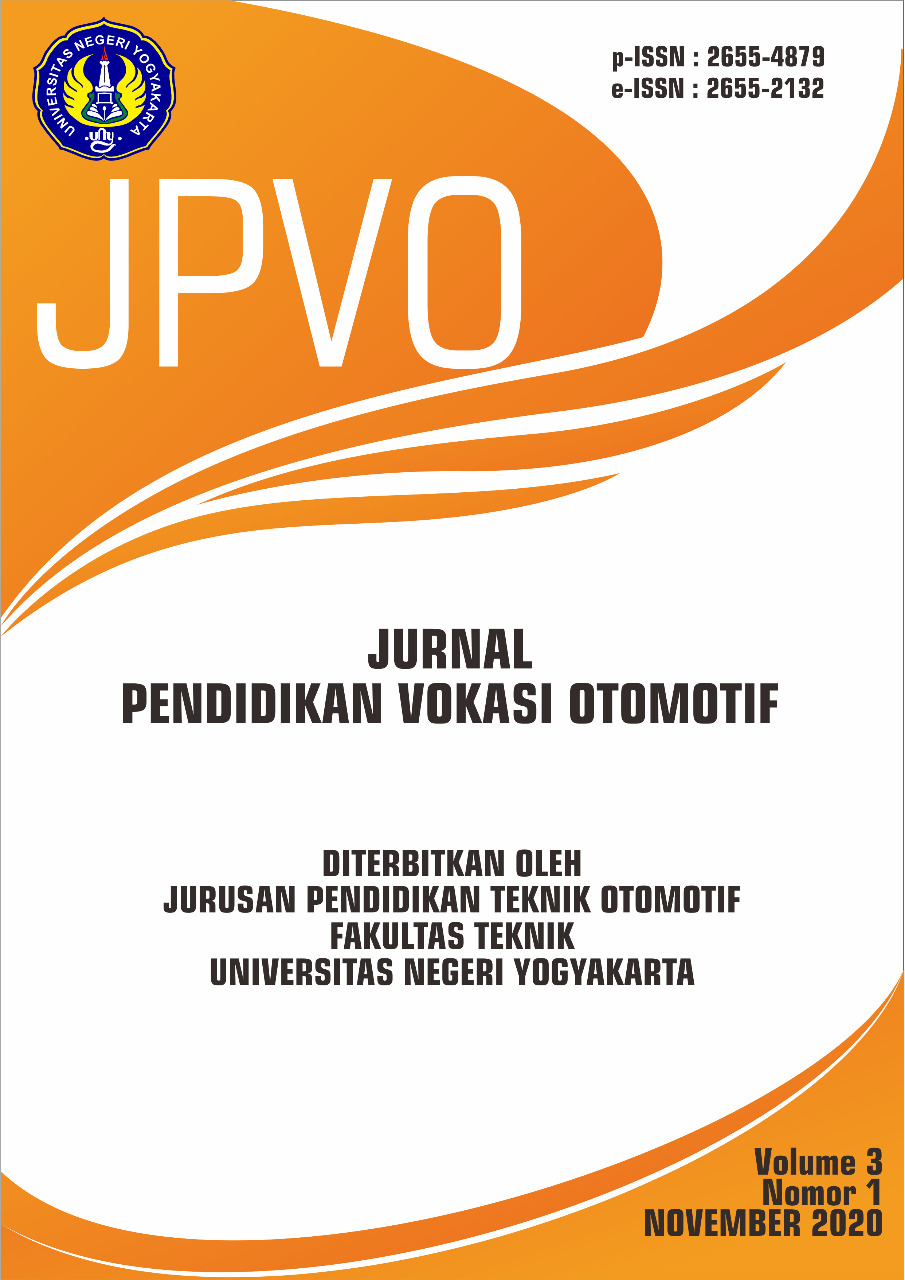RANCANG BANGUN DAN EVALUASI KINERJA SIMULATOR SISTEM PENDINGIN ENGINE TERHADAP TIGA JENIS CAIRAN PENDINGIN
DOI:
https://doi.org/10.21831/jpvo.v8i1.86284Keywords:
simulator, engine cooling system, Radiator coolant, demineralized water, automotive educationAbstract
This study aims to design and develop a simulator of an automotive engine cooling system that serves both as a practical learning tool and an experimental platform to evaluate the effectiveness of three types of coolant fluids: radiator coolant, mineral water, and demineralized water. The simulator was built using an Arduino-based system equipped with temperature sensors, a heating element, a water pump, and a radiator fan. The experiment focused on three key indicators: the time needed to reach engine operating temperature, the temperature difference between radiator inlet and outlet (ΔT). Results showed that mineral and demineralized water outperformed radiator coolant in terms of thermal efficiency, particularly in heat transfer rate and temperature drop. Beyond numerical results, the simulator also enabled learners to directly observe coolant flow and the function of each component, enhancing their conceptual understanding. This study contributes to the development of accessible, practice-based automotive learning media, while also offering experimental insight into alternative coolant fluids in the context of vocational education.
Keywords: simulator, engine cooling system, radiator coolant, demineralized water, automotive education
Penelitian ini bertujuan merancang dan membangun sebuah simulator sistem pendingin engine kendaraan ringan yang tidak hanya berfungsi sebagai media pembelajaran praktik, tetapi juga sebagai alat untuk mengevaluasi efektivitas tiga jenis cairan pendingin, yaitu radiator coolant, air mineral, dan air demineralisasi. Simulator dikembangkan dengan menggunakan sistem berbasis Arduino, dilengkapi dengan sensor suhu, elemen pemanas, pompa air, dan kipas radiator. Pengujian dilakukan dengan fokus pada tiga indikator utama: waktu untuk mencapai suhu kerja, perbedaan suhu antara inlet dan outlet radiator (ΔT). Hasilnya menunjukkan bahwa air mineral dan air demineralisasi memberikan performa pendinginan yang lebih baik dibandingkan radiator coolant, terutama dalam hal efisiensi pelepasan panas dan stabilitas suhu. Selain memberikan data eksperimen, simulator ini juga memungkinkan mahasiswa mengamati langsung aliran cairan pendingin dan cara kerja setiap komponen, sehingga membantu meningkatkan pemahaman konsep secara menyeluruh. Penelitian ini memberikan kontribusi nyata dalam menghadirkan media praktik yang aplikatif serta memperkaya referensi eksperimen cairan pendingin dalam lingkungan pendidikan vokasi.
Kata Kunci: simulator, sistem pendingin engine, radiator coolant, air demineralisasi, pendidikan otomotif
References
Abd, M., Zulfadli, T., Yusuf, M., Kamarullah, Mulkan, A., Azmal, S., & Zulfan. (2024). Analisis Perubahan Suhu Pada Sistem Pendingin Radiator Mesin Toyota Corola. Mekanikal, Inovasi, Dan Teknologi, 10(2), 486–493.
Arismunandar, W. (2005). Penggerak Mula Motor Bakar Torak. Penerbit ITB.
Arleiny, D.P.Y, N. A., & Suharto. (2021). Evaluasi Peran Laboratorium Simulator Navigasi Jurusan Nautika Terhadap Kompetensi Taruna Tingkat I. Jurnal 7 Samudra, 6(2), 53–60. https://doi.org/10.54992/7samudra.v6i2.116
Elfiano, E., Hastuti, K., Suripto, H., Rahman, J., Subekti, P., & Zinomeza, E. (2024). PENGARUH WATER COOLANT TERHADAP EFEKTIFITAS RADIATOR PADA MESIN TOYOTA KIJANG SERI 4K. 15(2), 783–795. https://doi.org/10.21776/jrm.v15i2.1533
Gunawan, F., & Wilarso. (2020). Identifikasi Kerusakan Tutup Radiator Terhadap Suhu Engine Toyota Kijang 5K. Journal of Mechanical Engineering Manufactures Materials and Energy, 4(1), 24–30. https://doi.org/10.31289/jmemme.v4i1.3535
Halderman, J. D. (2012). Automotive Technology Fourth Edition (Principles, Diagnosis, and Service) (V. Anthony (Ed.); 4th ed.). Pearson Education.
Handayani, S. A., Suwignyo, J., & Fatra, F. (2021). Meningkatkan Kompetensi Pendingin Mesin Melalui Metode Tutor Sebaya Dengan Media Engine Stand. Journal of Vocational …, 3(1), 37–41. https://e-journal.ivet.ac.id/index.php/joveat/article/view/1648%0Ahttps://e-journal.ivet.ac.id/index.php/joveat/article/download/1648/1187
Haris, Effiandi, N., & Asmed. (2022). Perbandingan Penggunaan Cairan Pendingin Radiator Terhadap Temperatur Kerja Mesin Mobil Toyota Avanza 1.5 S M/T. Jurnal Teknik Mesin, 15(1), 20–25. https://doi.org/10.30630/jtm.15.1.787
Hariyanto, A., & Imam. (2022). Pengaruh Jenis Coolant Standard Dan Coolant Prestone Pada Sistem Pendingin Terhadap Temperature Engine Toyota Innova Diesel 2.4 G A/T. Mekanik, 15(2). http://ejurnal.polnes.ac.id/index.php/mekanik/article/view/333%0Ahttps://ejurnal.polnes.ac.id/index.php/mekanik/article/download/333/522
Musa, Budiyono, A. F. (2019). Analisa Gangguan Sistem Pendingin Pada Mesin Avanza 1300 CC. Surya Teknika, 3, 39–46.
Muzaqi, M. I., & Sampurno, Y. G. (2022). Implementasi Metode Pembelajaran Tutor Sebaya Guna Mengingkatkan Hasil Belajar Siswa SMK NU Hasyim Asyari Tarub. Jurnal Pendidikan Vokasi Otomotif, 4(2), 89–106. https://doi.org/https://doi.org/10.21831/jpvo.v4i2.51898
Santosa, K. Y., Wichaksana, A., Ardiansyah, M. H., & Sulistyo, A. B. (2024). Pengaruh Variasi Cairan Pendingin (Coolant) Terhadap Potensi Overheating Pada Engine Diesel (Studi Kasus Mitsubishi L300). Berkala Forum Studi Transportasi Antar Perguruan Tinggi, 2(1), 40–47. https://doi.org/10.19184/berkalafstpt.v2i1.889
Subeki, K., Sugiarto, T., Maksum, H., Dani Saputra, H., & Wagino. (2024). Pengembangan Simulator Sistem Pengisian IC Regulator sebagai Media Pembelajaran Siswa SMK. MSI Transaction on Education, 5(1), 1–12. https://doi.org/10.46574/mted.v5i1.132
Wiharno, O., & Agus, M. (2019). Analisis Sistem Pendingin Engine Pada Pembuatan Life Engine Stand Nissan Sunny Ga15. Torsi, 1(1), 1–7.
Yunus A. Cengel, A. J. G. (2015). Heat and Mass Transfer Fifth Edition Fundamental & Application. McGraw-Hill Education.
Downloads
Published
How to Cite
Issue
Section
Citation Check
License

This work is licensed under a Creative Commons Attribution-ShareAlike 4.0 International License.
Jurnal Pendidikan Vokasi Otomotif allows readers to read, download, copy, distribute, print, search, or link to the full texts of its articles and allow readers to use them for any other lawful purpose. The journal allows the author(s) to hold the copyright without restrictions. Finally, the journal allows the author(s) to retain publishing rights without restrictions

Jurnal Pendidikan Vokasi Otomotif is licensed under a Creative Commons Attribution-ShareAlike 4.0 International License.
Based on a work at https://journal.uny.ac.id/index.php/jpvo.









